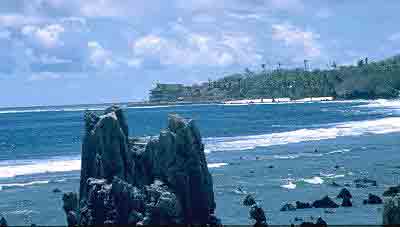|
|
|
|
| Missing In Action (MIA) | Prisoners Of War (POW) | Unexploded Ordnance (UXO) |
| Chronology | Locations | Aircraft | Ships | Submit Info | How You Can Help | Donate |
|
  7th AF April 20, 1943  Peter Flahavin 1996  Google Earth 2019 |
Location Nauru Island is an oval shaped island near the equator in the southwestern Pacific Ocean in the Republic of Nauru. Also known as simply Nauru. formerly known as Pleasant Island. The island has a circumference of 12 miles and an area of 8.1 square miles. Today, Nauru divided into fourteen administrative districts. Yaren serves as the administrative center. Nauru has no capital. Prewar In 1888, Germany annexed Nauru as part of the Marshall Islands Protectorate. In 1900 a British company discovered phosphate on the island and negotiated with Germany for mining rights. In November 1914 Nauru was seized by Australian troops under the command of Captain Norrie who became acting military administrator for Nauru and the island remained under British control until 1921 when a League of Nations mandate granted administrative rights to the United Kingdom, Australia and New Zealand plus the establishment of the British Phosphate Commissioners (BPC) to mine phosphates from the island. Wartime History During World War II, the island had the unique distinction of being attacked by Germany, Japan and the United States with action by Free French, Australian Navy and U.S. Navy warships in the sea off Nauru. Australian, German, Japanese and American missions against Nauru December 27, 1940–October 30, 1944 On June 12, 1940 HMAS Manoora (F48) intercepted Italian merchant ship Romolo and scuttled her off Nauru. During December 1940, two German raiders Komet and Orion sank five Allied merchant ships off Nauru. On December 27, 1940 Komet bombarded the phosphate mine damaging the cantilever loading wharf, oil tanks and other facilities. On July 17, 1941 Norwegian cargo ship Skagerak helped evacuate the Europeans from Nauru. On February 23 1942, La Tromphant evacuates 61 Europeans, 391 Chinese and 49 military personnel from Nauru Island then proceeded to Ocean Island to evacuate 823 Chinese and 232 Europeans. During late 1942, occupied by the Japanese Imperial Japanese Navy (IJN), Special Naval Landing Force (SNLF) commanded by Takeuchi plus Imperial Japanese Army (IJN) personnel. The Japanese built Nauru Airfield using local laborers with constructio starting in November 1942 with the runway completed January 14, 1943. During the Pacific War, the Japanese continued to mine phosphates from the island. During September 1943, roughly 1,200 Nauruans were deported to Truk as laborers. On September 2, 1945 after Japan officially surrendered the garrison was comprised of roughly 500 personnel that waited for Allied forces to arrive to accept their surrender. On September 13, 1945 the Japanese garrison on Nauru represented by IJA Captain Hisayuki Soeda and IJN Lieutenant Commander Kishimoto officially surrendered the Nauru garrison aboard HMAS Diamantina (K377). In the following days, Australian Army troops occupy Nauru Island and inspect surrendered equipment and defenses. Postwar After the surrender ceremony, occupied by the Australian Army, 11th Infantry Brigade under the command of Brigadier J. R. Stevenson with the 31/51st Infantry Battalion and 22nd Supply Depot platoon. On September 16, 1945 the Japanese Prisoners Of War (POW) were embarked and transported aboard HMAS Glenelg (J236) and SS River Burdekin bound for Torokina on Bougainville. The Australians captured LtCdr Nakayama, IJN as a suspected war criminal. Also captured was Lt Cmdr Naoomi Suzuki, POW 282001 was transported to Bougainville, Fauro and later tried for War Crimes at Rabaul and hanged. A small number of Japanese remained on the island to assist the Australians with cleanup and disabling the island's defenses. At least four Type 97 Te Ke Tankettes were captured near the oil storage tanks at the phosphate mine. After the Pacific War, only 700 Nauruans survivors returned. In 1947 the island was placed under United Nations Trusteeship and Australia resumed administration on behalf of the three partner governments: Australia, New Zealand and Great Britain. Today On January 31, 1968 became independent as the Republic of Nauru. During the 1970 the Japanese Government built a fringing ring road around the Island. Nauru Airfield (Nauru International Airport) Built by Japanese, still in use today. Nauru Museum (Nauru Military Museum) Collection of artifacts, weapons guns and aircraft wreckage. Japanese Type 97 Te Ke Tankette Four tankettes abandoned on Nauru, wreckage remained until the 1990s. Japanese 127mm Anti-Aircraft Gun Type 89 (1929) This gun was emplaced on Nauru. Japanese 150mm Coastal Gun Emplaced on Nauru, view of barrel and view of breech. Unexploded Munitions Frequently, unexploded ordnance (UXO) is discovered when new construction is undertaken or by excavation by the Nauru Phosphate Corporation occasionally dig up unexploded munitions including a Japanese 60kg aerial bomb and a U.S. 500 pound bomb, a sight to walk down a trail and suddenly it stops where a 1,000 pounder exploded. Japanese bunkers and trenches Nauru Island has extensive wartime bunkers and trenches. At least one 80mm coastal gun remains in a bunker. All other weapons were dumped into the sea in 1945. F6F-3 Hellcat Bureau Number 26088 Pilot Smith crashed December 8, 1943 B-25G "Coral Princess" Serial Number 42-64977 Pilot James crashed June 29, 1944 Contribute
Information Last Updated
|
Map Fallingrain Photo Archive |
| Discussion Forum | Daily Updates | Reviews | Museums | Interviews & Oral Histories |
|